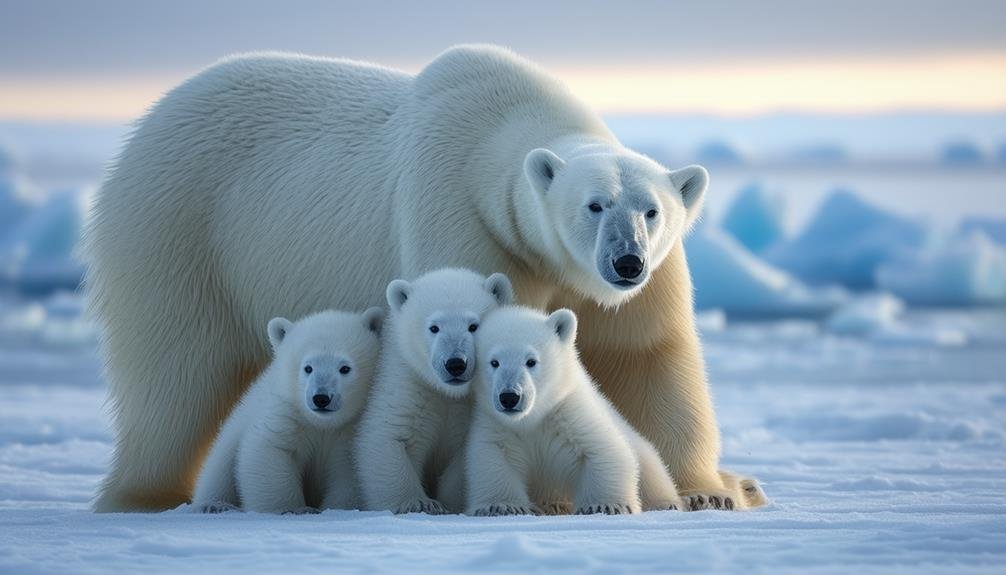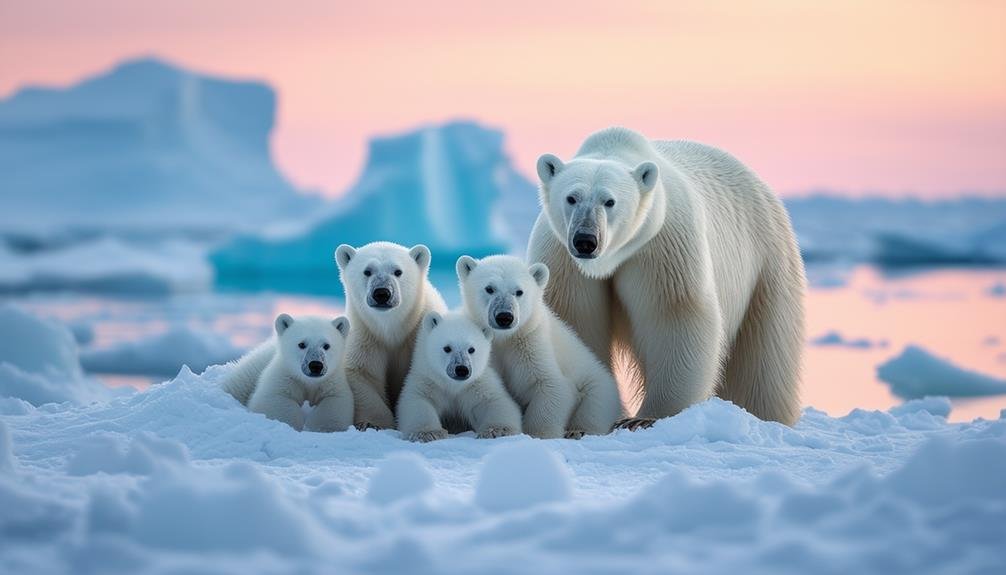Polar bear cubs do not hibernate during winter; they stay active within the safety of maternal dens. Unlike hibernation, where animals enter a deep sleep, denning involves semi-activity. Pregnant females dig these dens to give birth and nurse their young. Inside, the controlled environment keeps cubs warm and protected, enabling early development. The mother bear provides vital care and nourishment, ensuring the cubs gain strength for survival in the harsh Arctic. During this period, the cubs also begin learning important survival skills from their mother. To discover more about maternal care and survival strategies, continue exploring this fascinating topic.
Main Points
- Polar bear cubs do not hibernate during the winter months.
- Cubs remain active within the secure environment of their dens.
- Maternity dens provide warmth and protection for developing cubs.
- Mother bears nurse and care for cubs, ensuring their growth.
- Cubs prepare for Arctic challenges by learning survival skills from their mothers.
Denning Vs. Hibernation
Denning and hibernation, though often conflated, are distinct behaviors observed in polar bears and other wildlife. Polar bears spend part of their winter in bear denning, a behavior particularly exhibited by pregnant females. These maternal instincts lead them to dig maternity dens where they give birth and nurse their cubs. Unlike true hibernation, where animals enter a state of deep sleep and lower their metabolic rate, polar bear denning involves the mother remaining semi-active.
The mother polar bear reduces her energy needs by slightly lowering her body temperature, but she does not enter a full hibernation state. Instead, she is attentive, caring for her cubs and ensuring their initial development in the safety of the den. This environment provides a vital shield against the harsh Arctic winter, offering warmth and protection until the cubs are robust enough to face the outside world.
Bear denning is not just a survival strategy but an essential phase for the growth and nurturing of polar bear cubs. In contrast, hibernation is a deep, prolonged sleep aimed at conserving energy during periods of food scarcity, a behavior not aligned with the active care required in a maternity den.
Winter Activities of Cubs
During the winter months, polar bear cubs remain active within the safety of their dens. Unlike their mothers, who enter a state similar to hibernation, polar bear cubs do not hibernate. These cubs are born in dens during the harsh winter, and this secure environment plays a pivotal role in their early development.
Polar bear cubs rely heavily on their mothers for warmth and nourishment. The den provides a controlled climate, shielding the newborn cubs from the extreme Arctic cold. While the mothers are in a semi-dormant state, the cubs stay active, using the time in the den to grow and strengthen. This activity within the den is vital for their survival, as it prepares them for the challenges they will face once they leave the den.
The cubs stay in the den with their mother until they are robust enough to venture out. Typically, they emerge from the den in early spring, ready to explore the world outside. Therefore, the den serves as both a shelter and a nurturing space, ensuring that the cubs remain active and continue their development throughout the winter months.
Maternal Care in Winter

Maternal care plays an essential role in ensuring the survival and development of polar bear cubs during the harsh winter months. Unlike many animals, polar bears do not hibernate in the winter. Instead, mother bears create dens in snow drifts within the Arctic to give birth and provide necessary care for their cubs. These dens serve as a secure sanctuary, protecting the cubs from the severe winter conditions outside.
Newborn polar bear cubs are born blind, toothless, and extremely vulnerable. They rely entirely on their mother's maternal care for survival. The den area becomes a nurturing environment where the mother bear nurses her cubs, providing them with the essential nutrients found in her milk. This maternal care is vital for the cubs' health and growth during the winter months.
Throughout the winter, the mother bear remains in the den, ensuring that her cubs are kept warm and safe. This period of intensive care and protection allows the cubs to grow and develop until they are robust enough to venture outside. By the time spring arrives, the cubs are better prepared to face the challenges of the Arctic environment.
Survival Skills Training
As the winter months progress, mother polar bears begin the essential task of teaching their cubs the survival skills necessary for life in the Arctic wilderness. During this period, the den serves as a secure and nurturing environment where the cubs can grow and develop under the watchful care of their mother. Despite the harsh conditions outside, the den provides warmth and protection, important for the vulnerable cubs.
Mother polar bears play a crucial role in imparting essential survival skills to their cubs. These skills include recognizing potential threats, understanding the landscape, and eventually learning to hunt. Although polar bear cubs do not hibernate, they remain in the den throughout the winter months, relying on their mother for nourishment and guidance.
Inside the den, the mother polar bear ensures that her cubs receive adequate nourishment, which is vital for their development and strength. This period of close interaction allows the cubs to observe and mimic their mother's behaviors, laying the foundation for their future independence in the Arctic wilderness. By the time they are ready to leave the den, the cubs are equipped with the basic skills necessary to survive in one of the planet's most challenging environments.
Adapting to Arctic Conditions

Polar bear cubs must quickly adapt to the harsh Arctic conditions as they emerge from the safety of the den. Unlike many other animals, polar bears do not hibernate during the winter. Instead, mothers and their cubs remain active within the confines of their den. Born in January or February, these cubs are initially blind, toothless, and highly vulnerable. During this significant denning period, the mother plays an essential role in nursing and protecting her offspring, ensuring they develop the necessary strength and resilience.
The denning period is vital for the cubs' survival. It provides a sheltered environment where they can grow and gain the physical capabilities needed to face the Arctic environment. The mother's constant care and warmth are pivotal, as the cubs are unable to survive on their own during these early stages. Once they are strong enough, the family leaves the den to navigate the icy terrain.
Adapting to the Arctic conditions involves the cubs learning to forage and hunt under their mother's watchful eye. This period of active learning and adaptation is crucial, as it equips the cubs with the skills and experience required to survive in one of the Earth's most extreme environments.
Do Polar Bear Cubs Participate in Winter Antics While Hibernating?
Polar bear cubs aren’t truly hibernating during the winter months, rather they’re snuggled in dens, protected by their mothers. While they may not engage in full-fledged play outside, polar bear cub winter antics inside the den can include gentle nudges and movements as they gain strength for the harsher cold waiting outside.
Conclusion
To sum up, polar bear cubs do not hibernate during the winter but remain active in their dens. The period involves denning, where cubs stay with their mothers who provide important care and training. This time is vital for learning survival skills and adapting to the harsh Arctic environment. Understanding these behaviors enhances knowledge of polar bear ecology and informs conservation efforts aimed at protecting this vulnerable species in a rapidly changing climate.


